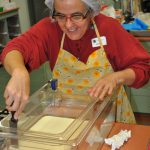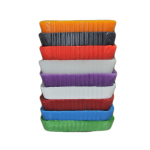How to freeze milk when you have an excess
Do you have a fresh supply of milk and it is too much that you cannot use it all? You are the envy of many cheesemakers across Australia. Or do you want to want to have access to goat milk that may not be as readily available later in the year? Freezing that milk is an option available to you. But what is the best way to freeze milk?
Freezing and Cooling Systems: Domestically you may not have access to larger cooling or freezing systems such as cold rooms, freezer rooms or milk storage vats. These items are designed to chill or freeze the milk in a very short period. The domestic refrigerator or freezer will only reduce the temperature of the milk over a much longer period. The aim of freezing should be to remove the heat from the milk as quickly as possible. Simply put, you want to achieve freeze fast and cool slowly. In our summer weather it’ is very easy to do the opposite. Slow freezing and fast thawing produce sharp ice crystal structures that damage the fat and protein in the milk and may give milk and inferior structure that will make an inferior cheese. The ‘sludge’ that you find in the bottom of containers are damaged fat and protein cells.
Volume of milk to be frozen: Fresh milk is lower in both microbial and enzyme activity than older milk. If you are getting a few litres per day you may not want to freeze each day you may want to composite it. But you must make a judgement based on how often you freeze, the volume of milk that needs to be frozen, the age of the milk to be frozen, and your time available to undertake the freezing.
Containers: Use containers that are freezer safe. Glass has a better heat transfer for chilling and freezing than plastic. It’s not that significant though so plastic if that is all that is available is also fine. However, the smaller the container the better. Two x two-litre containers will freeze a lot faster than one x four-litre containers.
Heat load: Remove the initial heat out in the milk before freezing it by chilling it, basically have the milk as cold as you can. If the milk is straight from the animal it will be around 37°C, so add it straight to the sanitised containers used for freezing, then use ambient water or even better, chilled water to reduce initial heat load. Keep direct light, especially sunlight off the milk. Leave the then mostly chilled milk in the fridge to finish cooling and await freezing. When freezing, leave an air gap between the individual containers to aid cooling.
Thawing: The easy way to thaw frozen milk is to leave the frozen milk on the bench. But thawing should be slow. The best way to thaw the milk is to leave it in the fridge for 24 hours.
Pasteurisation: You may want to use the milk as raw milk so good hygiene along the way is important. However, if you want to pasteurise the milk you need to choose between pasteurising the fresh milk before freezing or the thawed milk. My personal preference is to pasteurise after thawing. There is less heating involved and the heating step in closer to the actual consumption or the cheesemaking step.
Hygiene: Keep milking, personal and equipment hygiene high always for milk for human consumption. Equipment to be well cleaned and then well sanitised immediately before use.
Labelling: Adequately label all containers with the date of manufacture and date of freezing.



